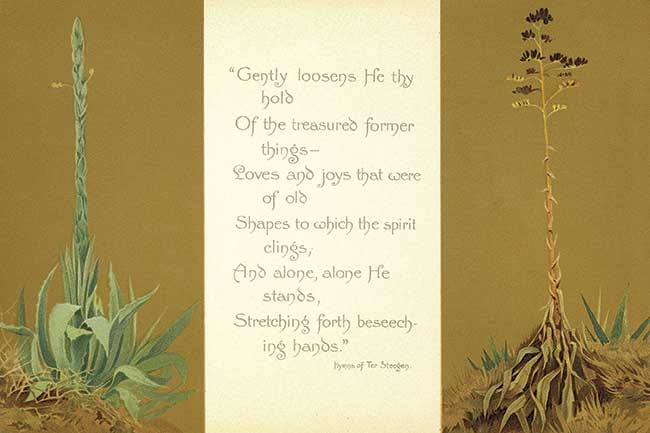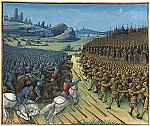“Life is reigning, not death”

[Lilias Trotter, Plate from Parables of the Christ-life, 1899—Used by permission of Lilias Trotter Legacy and Arab World Ministries of Pioneers]
Trotter’s Parables of the Christ-life (1899) again combined careful observation of nature with description of it in text and art to convey her message.
LIFE—the first glance would hardly find it on this African hillside in the summertime. The hot wind of the desert has passed over it, and the spring beauty of iris and orchid, asphodel and marigold, has vanished. Nothing is to be seen but the mellow golden-brown of the grass, broken by blue-green aloe leaves, and here and there a deep madder head of dried-up fennel.
Yet life is reigning, not death, all the while; it is there, in infinitely greater abundance than when the field was green—life enough to clothe a score of fields next year.
Stoop down and look into that withered grass, and a whole new world of God’s handiwork will come into view in the burnt-up tangle. For of all the growing things out here, the seed-vessels are among the most wonderful. Even little insignificant plants that would hardly catch your eye when in flower, develop forms of quaint beauty as the capsules ripen. And now that all is finished, they lie stored with vitality in the midst of the seeming loss around.
Do you see the parable? We will trace it out step by step. Back we must go, to the days of early spring. The annuals that clothed the field had each but one life then; a perishing life, though it looked so strong in its young vigor. Left to itself, it stood “condemned already.”
But the critical moment came, changing its whole destiny, when a new birth took place: the vitalizing pollen was received by the pistil, and set up the reign of a fresh undying creation. All that had gone before in the plant’s history was a preparation for this moment: all that followed was a working out to its fruition.
“Verily, verily I say unto thee, except a man be born again, he cannot see the Kingdom of God.” Every soul carries like the flower a possible life, other than that of its first birth; more than that, to every soul within reach of the Gospel there comes probably a moment when the Life of God draws near and could be received if it were willing. There is a crisis like that which the flower reaches, when all things are ready. If that crisis is not seized, nothing lies before the plant but useless, irrevocable decay; the power to receive withers and vanishes; and nothing can renew it. . . .
“Open and receive”
The most wonderful secrets of the plant world hang round the process of fertilization, and the ways in which these springs of the second birth are guarded and set going, but the flower’s simple work is to open and receive. . . .
It is utterly, unbelievably simple. Receive Jesus with a heart-grasp, and you will find, like the flower, a spring of eternal life, entirely distinct from your own, that is perishing, set working deep down in your inmost being.
And all that is needed, for the fulfilment of God’s uttermost purpose for you, is that this “new man” should be formed and that the old should pass away.
From the very outset of its new birth we see this double process going on in the plant. Within a few hours the throb of new life has spread through the flower, with this first result, that the petals begin to wither. Fertilization marks the striking of the death-blow to all that went before. Look at a clover head; do you know why some of the spikes are upright and others turned downwards and fading? It is because these last have received the new tide, and the old is ebbing out already.
The birth-peal and the death-knell rang together. Fertilization marks the death of the flower and the death of the flower the death of the annual, though the carrying out of its doom comes gradually.
And in like manner the sentence of death passes, in the Cross, on the old nature in its entirety, as the new comes into being. This is the one only basis and groundwork for all carrying out in our practical experience of what that death means. Once for all let this be clear. Apart from the work done on Calvary, all working out of a death process in our own souls is only a false and dangerous mysticism. . . . “I have been crucified with Christ.”—Yes, long before ever I asked to be—glory be to God! and yet as freshly as if it were yesterday, for time is nowhere with Him.
By Lilias Trotter
[Christian History originally published this article in Christian History Issue #148 in 2023]
from Parables of the Christ-lifeNext articles
Christian History Timeline: Lilias Trotter
A life of art and service. Trotter’s experiences amid the cultural and missional currents of the nineteenth and early twentieth centuries
the editorsCooperation for the gospel
Trotter’s mission was part of the exploding nineteenth-century evangelization of North Africa
Rebecca C. PateGod told her to go
Like Trotter, Amy Carmichael blazed her own missionary trail
Jennifer Woodruff TaitReaching the “Brotherhood men”
Trotter’s evangelization of Sufi Muslims fit within a larger context of Muslim-Christian relations
Edwin Woodruff TaitSupport us
Christian History Institute (CHI) is a non-profit Pennsylvania corporation founded in 1982. Your donations support the continuation of this ministry
Donate







